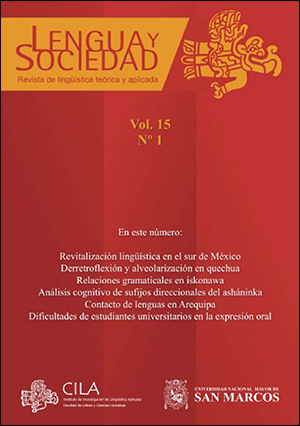The behavior of the directional suffixes in the Ashaninka language: cognitive analysis
DOI:
https://doi.org/10.15381/lengsoc.v15i1.22594Keywords:
Cognitive Linguistics, image schemas, directional suffixes, metaphorical sense, AshaninkaAbstract
This article is based mainly on a bibliographic study. In general, it focuses on the analysis of directional Ashaninka suffixes from the Cognitive Linguistics approach. Studies on this Arawak family language deal with suffixes descriptively, arguing that they provide different meanings, figurative or non-figurative, depending on the verb to which they are added. That is, the suffixes have other meanings outside the scope of directionality. The analysis based on image schemata, one of the basic principles of Cognitive Linguistics; offer an explanation of the motivation of those who speak Ashaninka in their use of such suffixes with figurative or metaphorical sense.
Downloads
Published
Issue
Section
License
Copyright (c) 2015 Luz Mery Infante Seminario

This work is licensed under a Creative Commons Attribution 4.0 International License.
AUTHORS RETAIN THEIR RIGHTS
a. Authors retain their trade mark rights and patent, and also on any process or procedure described in the article.
b. Authors can submit to the journal Lengua y Sociedad, papers disseminated as pre-print in repositories. This should be made known in the cover letter.
c. Authors retain their right to share, copy, distribute, perform and publicly communicate their article (eg, to place their article in an institutional repository or publish it in a book), with an acknowledgment of its initial publication in the journal Lengua y Sociedad.
d. Authors retain theirs right to make a subsequent publication of their work, to use the article or any part thereof (eg a compilation of his papers, lecture notes, thesis, or a book), always indicating its initial publication in the journal Lengua y Sociedad (the originator of the work, journal, volume, number and date).






